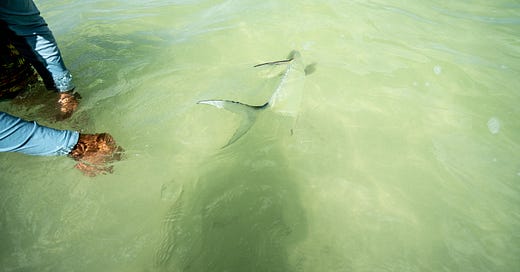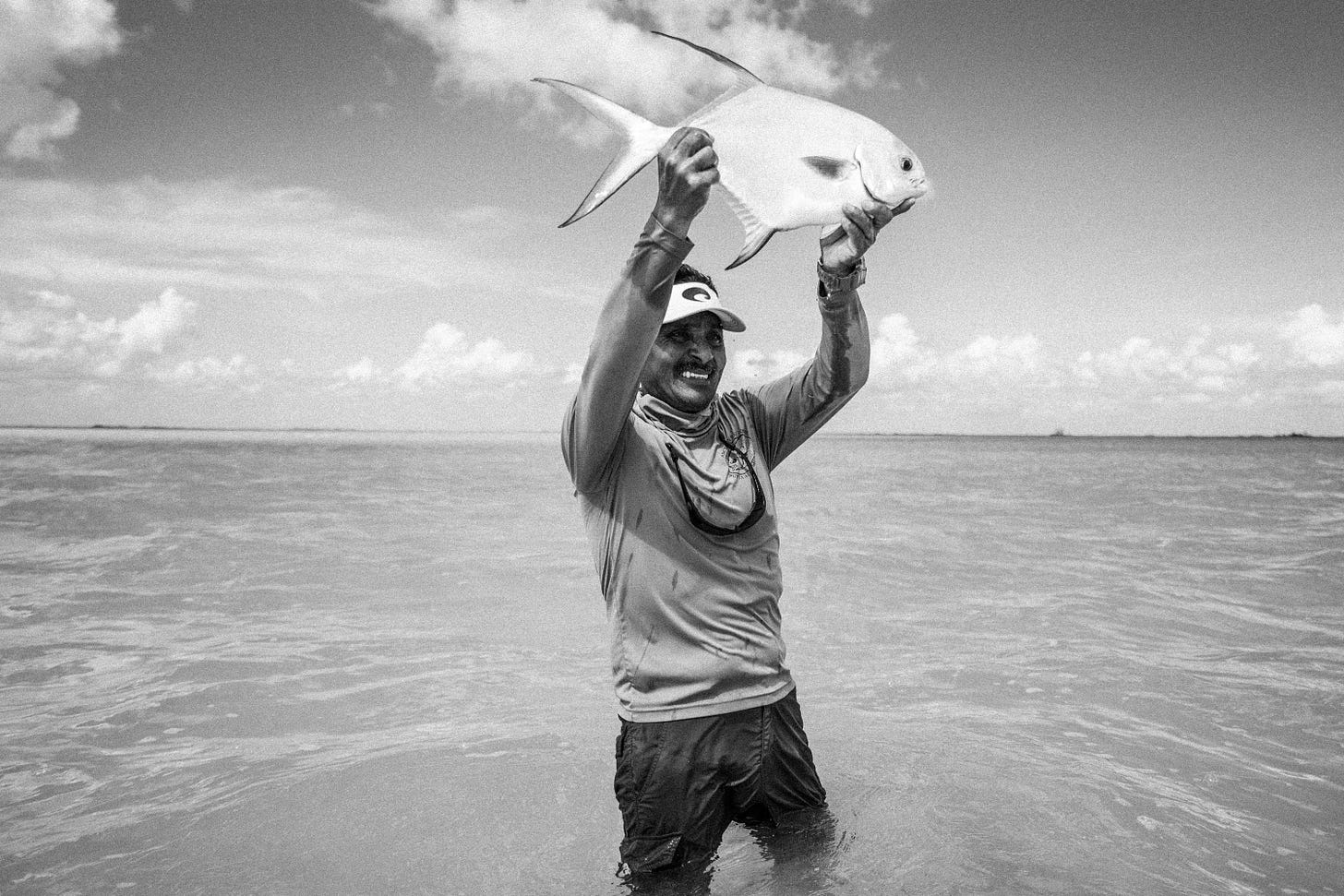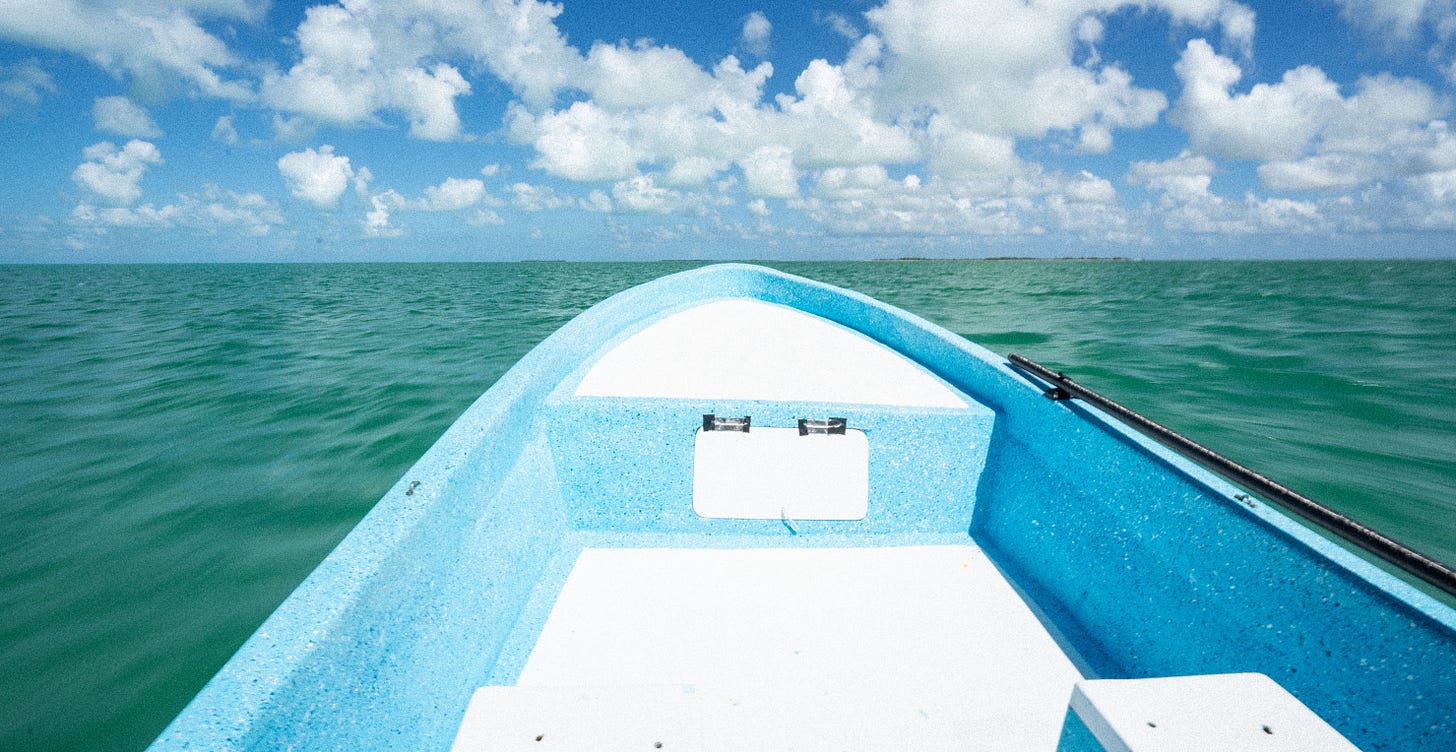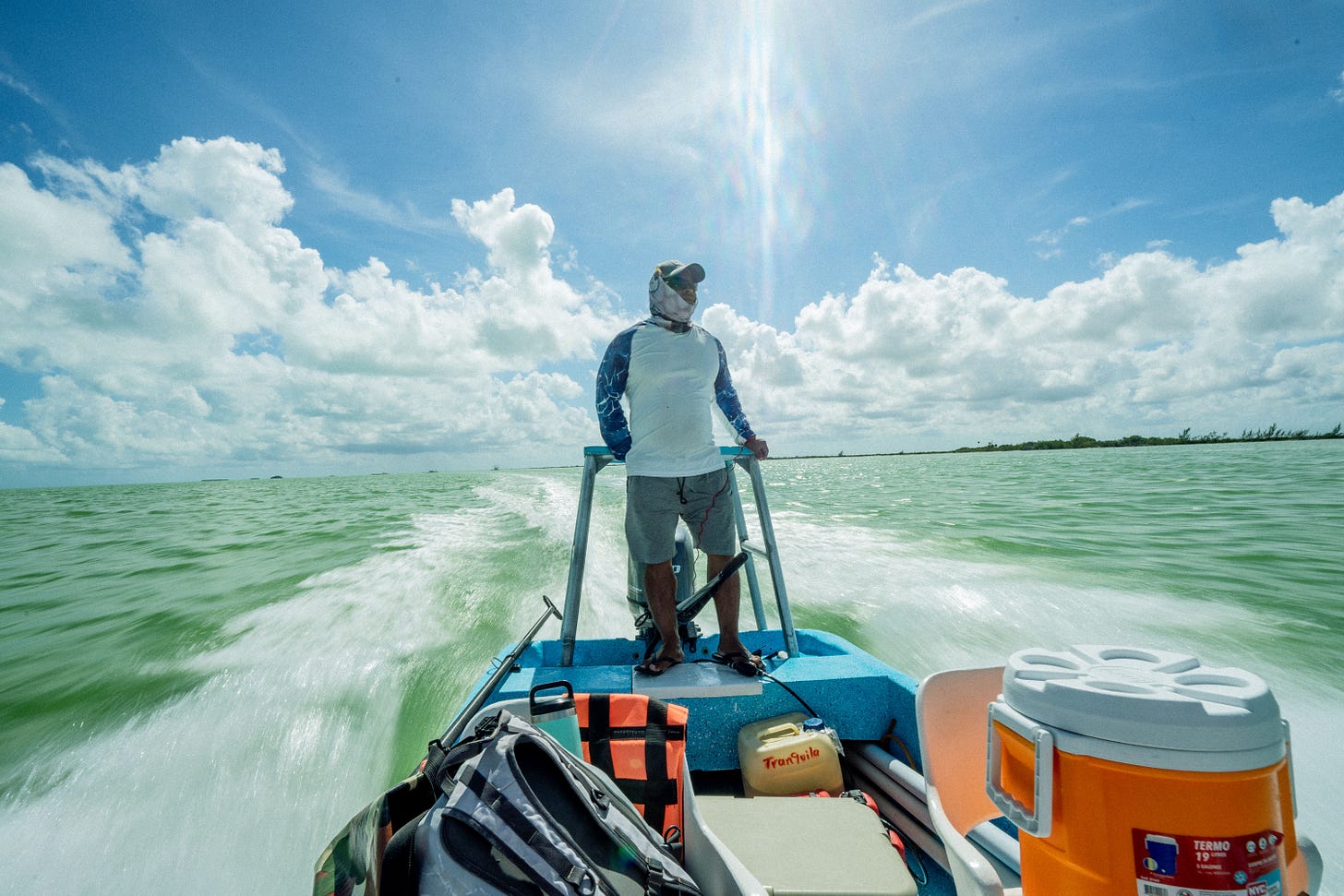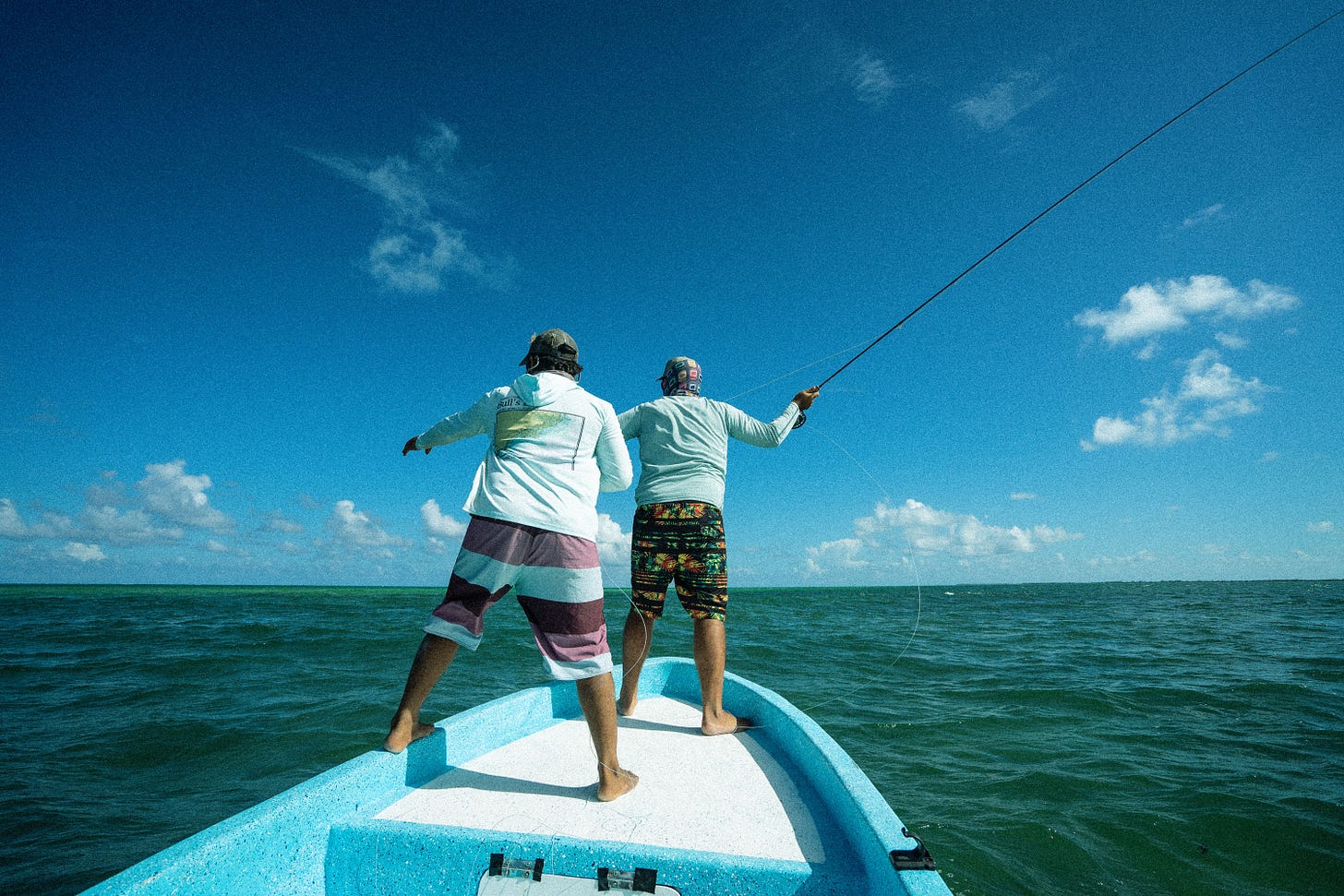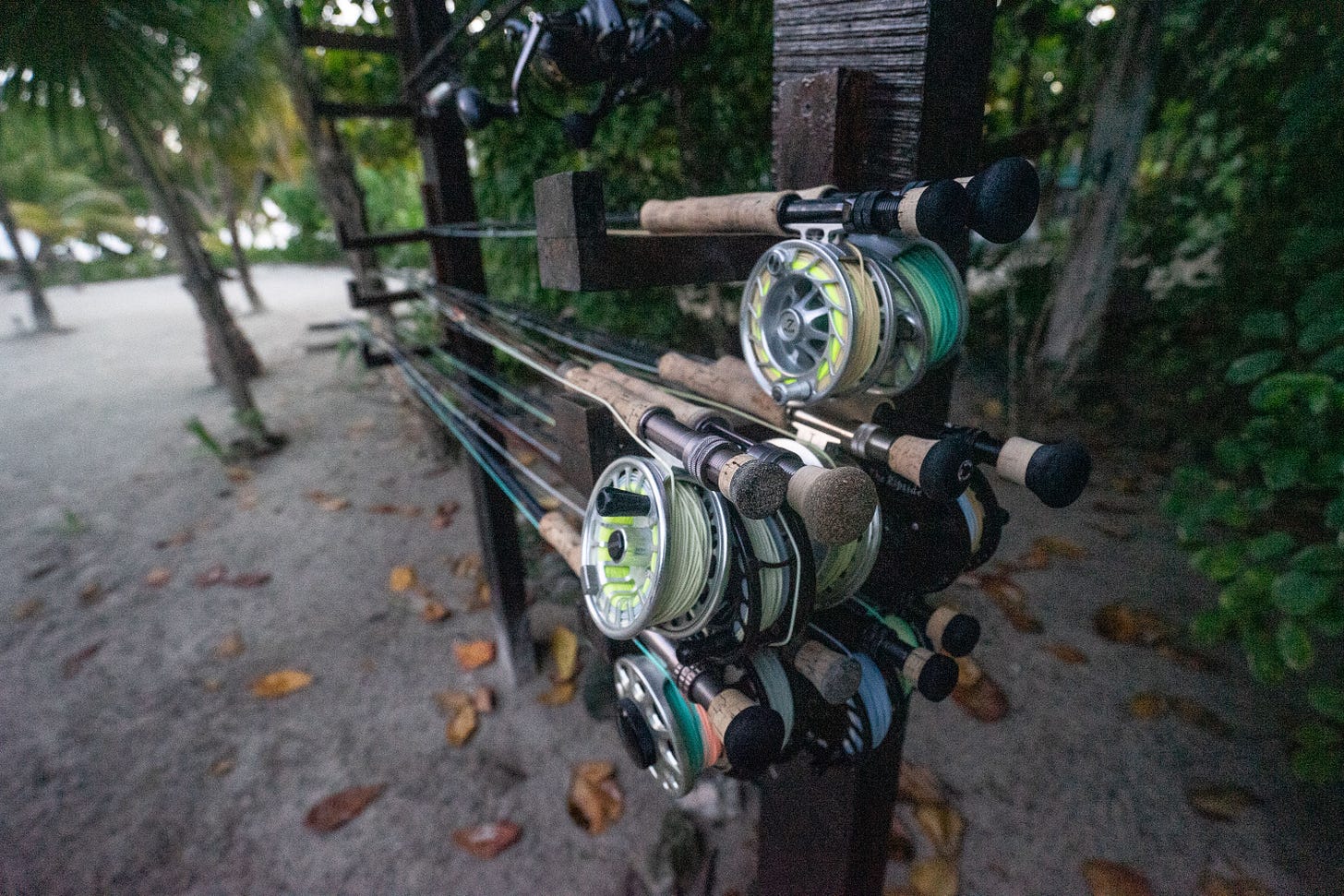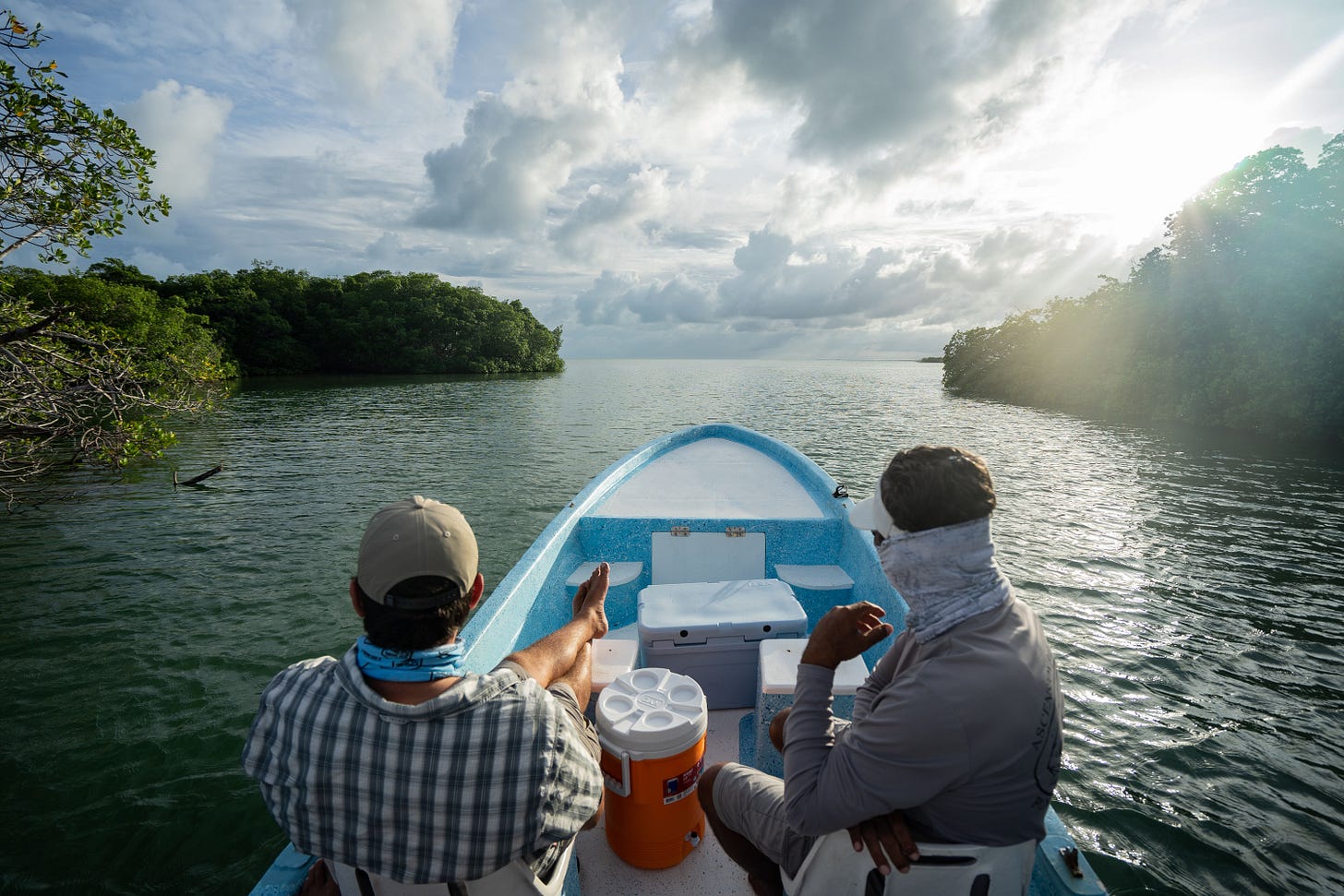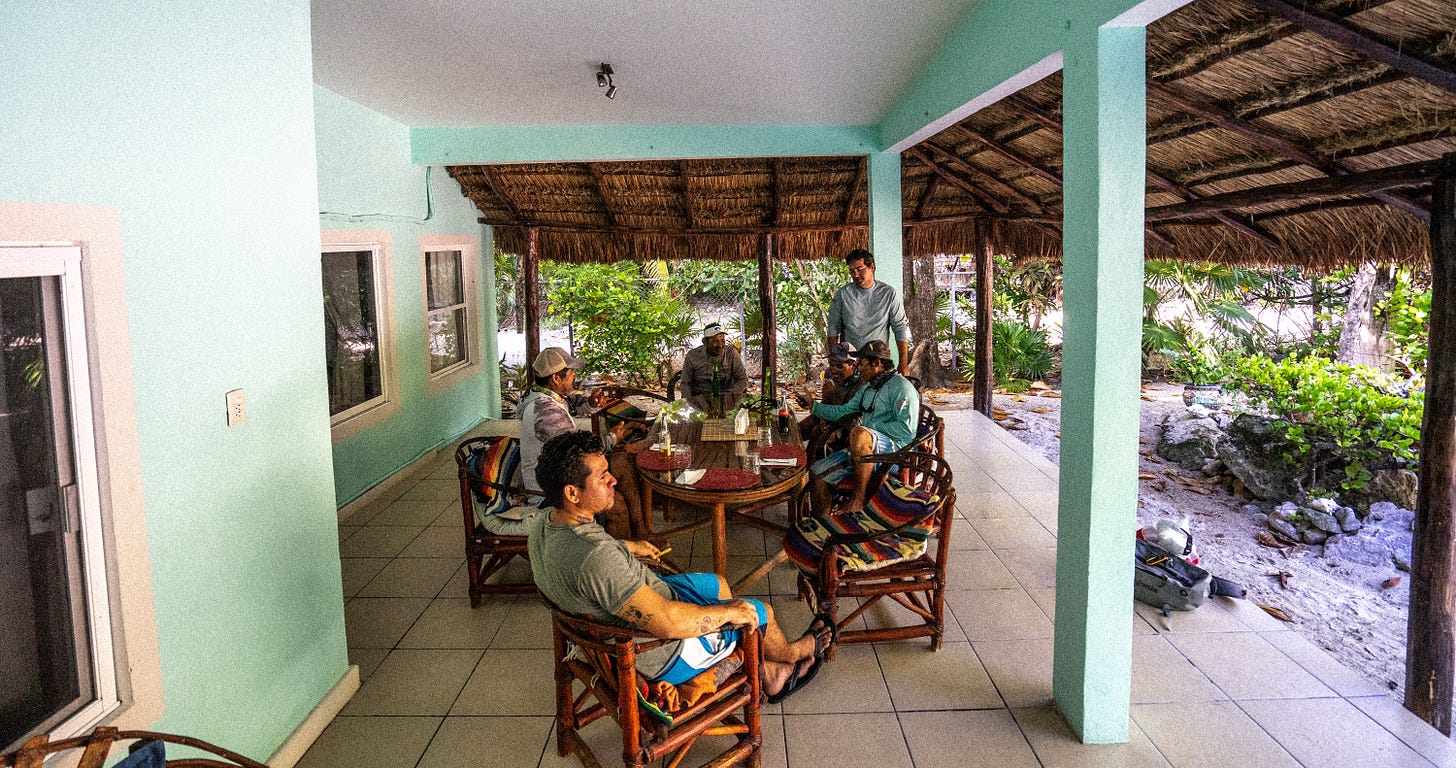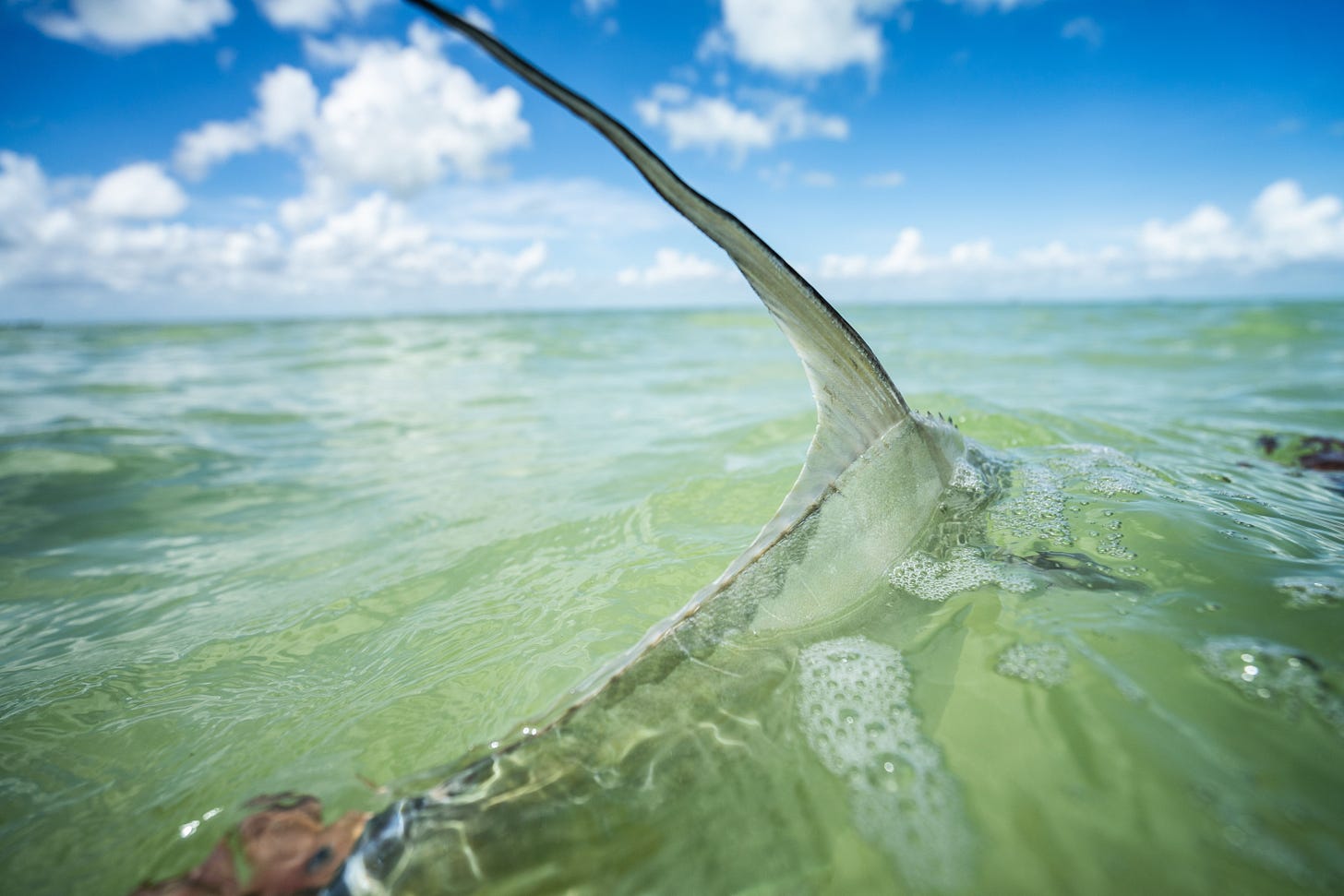I’m about to head to the airport to get on a flight down to the southern Yucatan near the border of Mexico and Belize for a week on the flats. I’ve been looking forward to this day for months, and am chomping at the bit to be back on the bow of a panga again scanning for fish. Below is an updated story of my first encounter with the black-tailed devil about 7 years ago.
After a 30 minute run on the 23-foot locally-built Panga “Tranquila”, aptly named to calm your nerves, we pull up to the first permit flat. A few seconds after turning the motor off, a school of ten fish is cruising straight for the boat. Under the water, the permit are minding their own business and searching for food just like any other day - but up on the boat, total chaos ensues.
Our local guides Oscar and Abraham are frantically yell-whispering in Spanish telling me to take the shot. So I quickly jump up on the bow as the school heads our way, and strip off fifty feet of fly line from my reel to get ready to make the cast. As I go to take the shot, I notice that my fly is caught up in a bird nest of fly-line. The pressure got the best of me and I’d rushed the preparation. By the time I get my line sorted, all but eight seconds later, the fish are nowhere to be seen, before I can get a cast off - and I quickly learn why the boat’s name is Tranquila.
Permit (or “Palometa”, en Español) don’t want to be exposed on the knee-deep flats of the ocean where you can see them - they’d much prefer to be safe in the deep, but they have no choice. The flats are the best place for them to find food like crabs, shrimp, and small fish. By analyzing certain tides and conditions, you (more like, your guides) are able to predict where they might be at certain times, giving yourself the best odds of running into them while they’re searching for their next meal.
They’ll typically cruise around oblivious to anything but their next meal, but with their wide-forked tails and steel-spined bodies, they have the ability to maneuver like a torpedo whenever they want to. Their quickness and strength-per-inch is astonishing — part of what makes them a top catch-and-release game fish. As fun as it sounds to catch one, they are notoriously smart and stubborn fish. So much so that they’ve earned a reputation as being the most frustrating fish to catch on a fly. They’re hard to find, elusive once you find them, and totally unpredictable if you’re lucky enough to even get a cast off at one. It’s a game that the permit control, not you — like a game of cat and mouse, but you’re the mouse, and the cat is smarter, faster, and a ghost.
That’s why we’re in Mexico — one of the few places around the world you can actually find them pretty consistently. The name of the game when trying to catch permit is finding the perfect balance between skill and luck. It’s more like hunting than fishing, and you need to be able to accept the fact that the odds are as much against you as they are in your favor. It’s not uncommon for people to go all the way down to Mexico for a week, and not catch one. Just seeing a few fish is considered a good day in many permit fisheries. Some days they just aren’t around, or aren’t willing to play. Some people go years trying to catch one without any luck.
There are a ton of things that need to go perfectly for the stars to align. There are times where you need to be able to cast a fly 80 feet, into the wind, right onto a dinner plate in order to even have a chance. Even if you’re a world-class fly caster, they might reject a perfectly casted fly 9/10 times. And this is what makes the permit so desirable to fly anglers: the challenge is so great that the reward is unmatched. Even a fish of just a few pounds is regarded as an accomplishment. The small ones may be called learner’s permits, but they still get respect. Obviously everyone’s after the large old fish, but connecting with any permit at all is respectable.
If you happen to even get a shot at a fish, one of the most common mistakes made when permit fishing is the typical trout fisherman’s instinct to lift the rod high and quickly in order to set the hook as you are vehemently taught when learning how to fish for trout.
Permit feed and behave differently than trout, have different mouths, movements, and tendencies, so the technique for actually hooking up requires you to strip-set the line by quickly pulling the slack out of the fly line with your free hand, instead of setting the hook as you would on a trout, lifting the rod quickly to remove slack in the line to get tight to the fish. If you “trout-set”, you’re likely going to pull in too much slack too quickly and your chance at the fish is gone. Muscle memory is your worst enemy in this case and can easily take over when you’ve only got less than a second to think.
When everything finally comes together - the tides are right, the wind is cooperating, the sun is high enough to see the fish, you actually find a permit, you get a shot, you make a good cast, you’ve chosen the right fly, the fish decides to eat the fly, and it actually eats the fly — you need to stay focused on your technique amidst the chaos, hoping you don’t trout-set and blow your chance at the final moment.
In Ascension Bay, Mexico, permit are a legally protected catch-and-release only fish. The Bay is part of a protected 250 square-mile Sian Ka'an Biosphere, where, by law, only 40 boats are allowed to fish per day, keeping pressure on the bay at a minimum. On a small peninsula in the northern area of Ascension Bay lies Punta Allen, a sleepy village of only 600 people. Punta Allen is a few hours south of Tulum, only accessible by a bumpy dirt road through the jungle, complete with a river crossing near the end lined with saltwater crocs.
It’s like going back in time when you get down there. Dirt roads, no cell service, one grocery store, a community sand soccer field, and a giant 25-foot sculpture of a permit in the center of the town. Punta Allen’s economy relies primarily on lobster fishing, ecotourism, and guided fly-fishing. The town lives and breathes fishing—it’s in their blood. The guides and their families have been interacting with the ocean and fishery for generations.
The guides are so good, and take so much pride in what they do, that they keep track of their lifetime number of every single permit that they’ve landed. It’s a source of well-respected pride in the town amongst the guides. And not only do they have incredible eyesight — many of them can cast a 9 weight better than any guests that’s fishing from their pangae, with both right and left hands. Some of them can even cast an entire fly line (~90 ft), without a rod. Their permit fishing knowledge, fundamentals, and natural instincts are some of the best in the world.
Ascension Bay Lodge, our home for a few days, is the last property at the end of the only road down in Punta Allen. The lodge is lined with palm trees and is on the waters edge, with a palapa covered patio and homemade horse-shoe out front. From the lodge, you can see the pangas tied up to the beach out front, ready for battle the next day. At ABL, you’re quick to realize that it’s an oasis within an oasis. Daniel Marquez, the owner of the lodge, caught his first permit on a trip to Mexico when he was 19, and knew he would end up there someday after that moment.
He’s now built his life down in Punta Allen and is an integral part of their economy and community - providing work and opportunity for numerous guides and staff. He’s married to a local and plans to raise his two kids there. ABL is an independent, family-owned and operated business, and it feels that way when you’re there.
The lodge is filled with a vintage local map, Mayan art, and a bookshelf with everything from a few Hunter S. Thompson novels, a book called The Cigar Companion, and Permit on a Fly, a 1970s book that was my bible for the week. The hospitality and generosity at ABL is real, and many of the guests that stay there go there for that reason — apart from it being in the heart of an incredible permit fishery.
This is why a man called “Permit Bill”, a well known, 70-something permit fishing bum/legend, goes to ABL each year. He’s been going back to Punta Allen to fish for 30 years straight, usually staying for 3 or 4 months at a time, sleeping in a hammock. Bill has caught 54 Permit in his life, 11 of those from a kayak without a guide.
But Bill goes back to Punta Allen for more than just permit. He has ingrained himself in the Punta Allen community, which is what draws him back more than fishing itself. He’s done everything from building a soccer stadium for the community, to organizing annual Christmas gifts for all of the local kids. He’s known as “Abuelo” around town. He’s a humble guy who sees Punta Allen for much more than just a fishery, I think his permit-luck karma speaks for itself.
When we first arrived, Daniel and Abuelo were quick to tell me the only rule in Ascension Bay: if you’re lucky enough to catch a permit, tradition requires you to drink a shot of tequila, or you’ll bear the curse and may never catch one again. I laughed that off initially, and then was told that one guest chose not to do so, and didn’t catch a permit for 14 years.
By the end of day 3, it’s been a long few days of searching for permit and we’ve come back to the lodge each evening with little to show for it. At this point, we’re starting to accept the reality that it’s not going to happen. But we lick our wounds, play a few rounds of horseshoes, and head back inside the lodge. After a few Tequilas, Abuelo eventually jokingly says, “I never want to see a permit, ever again” before going off to bed.
On the final day, back on Tranquila, we’ve pulled up to another sand flat in search of fish. A Frigate, which can stay up in the sky without flapping its wings for an entire month at a time, floats above us. A good sign. We’ve been out all day and have had a few shots at fish — but the fish aren’t cooperating, as per usual. It’s been about an hour, maybe longer since we’ve seen any sign of life. I haven’t heard Abraham or Oscar say “Está muerto” yet, their way of saying “this flat is devoid of all life right now and there are no permit around”, so I know we still have a chance of seeing a fish.
Eventually, we see a fish cruise onto the flat from a distance. Like clockwork, chaos ensues on the boat. Oscar quickly says, “10 O’clock! 100 feet!” This time, my line is good to go — I’m ready for the shot, as soon as it gets within range. Right as I’m about to make my cast, a cloud drifts overhead, blocking the sun. The three-foot deep sand flat instantly turns from a crystal clear turquoise to an opaque grey blue and the ghost of a fish vanishes as if it was never there.
Visibility gone, I decide to cast my crab fly into the void anyway, where I thought the fish might go. I start hesitantly stripping my line back to the boat, and thirty feet out the line goes tight. A fish on the other end shakes and bumps a few times. “Probably a small bonefish,” says Abraham — there’s a lot of those out there in the same places where the permit live, and occasionally they’ll grab flies out of nowhere that were intended for permit. Not what we’re going for, but we’ll take it.
Then, it turns and briefly shows itself with a bright silver flash, and Abraham yells “Palometa! Palometa!”. The fish then sprints 150 feet in half a second. A nerve-wracking 15 minutes later, we managed to tail the permit by the boat. Finally, it’s in our hands. After days of waiting and spotting fish, placing perfect casts right on their heads with no prevail, fly changes, strategy changes, and countless locations, it came to us on a blind cast. We take a few quick photos, remove the hook, kiss it goodbye, and release it. After high fives all around, Oscar turns to me and says, “Hey, it’s better to be lucky than be good.” That right there was the best backhanded compliment I’ll ever receive.
It’d be pretty damn hard for the elusive permit to live up to its reputation more than it did that day. I’m glad I didn’t trout-set — because if I had known for sure that there was a fish right in front of us about to eat the fly, I wouldn’t have stood a chance. And it goes without saying, I drank that shot of tequila with delight.

